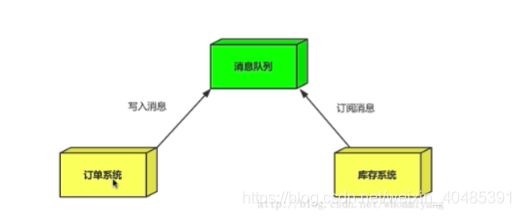消息队列RabbitMq精析
文章目录
-
- 1.Mq简介
-
-
- 1.什么是Mq
- 2.Mq有哪些
- 3.不同Mq的不同特点
- 4.AMQP
-
- 2.RabbitMq简介
-
-
- 1.RabbitMq基本消息模型-----直连
-
-
- 1.1生产者
- 1.2.消费者
-
- 2.RabbitMq基本消息模型----work queue
- 3.消息确认机制
- 4.RabbitMq基本消息模型----fanout
- 5.RabbitMq基本消息模型----Routing之订阅模型Direct(直连)
- 6.RabbitMq基本消息模型----Topic
-
- 3.Rabbitmq与Spring Boot集成
-
- 3.1 第一种hello world模型使用(一对一发布接受消息)
-
-
- 开发生产者
- 开发消费者
-
- 3.2 第二种work模型使用(平均分配消息)
-
-
- 开发生产者
- 开发消费者
-
- 3.3 Fanout 广播模型(发布/订阅模式,无routingkey)
-
-
- 开发生产者
- 开发消费者
-
- 3.4 Route 路由模型(发布/订阅模式,有routingkey)
-
-
- 开发生产者
- 开发消费者
-
- 3.5 Topic 订阅模型(发布/订阅模型,动态路由模型,可指定routingkey的模型范围)
-
-
- 开发生产者
- 开发消费者
-
- 4. MQ的应用场景
-
-
- 1.异步处理(发布/订阅模型)
-
- 4.2 应用解耦
- 4.3 流量削峰
1.Mq简介
1.什么是Mq
Mq翻译为消息队列(消息中间件),通过典型的生产者和消费者模型,生产者不断向消息队列中生产消息。消费者不断从队列中取消息。因为消息的生产和消费都是异步的,而且只关心消息的发送和接受,没有业务逻辑的侵入,轻松实现消息间的解耦。通过利用高效可靠的消息传递机制进行平台无关的数据交流。并基于数据通信来进行分布式系统的集成。
2.Mq有哪些
ActiveMq,RocketMq,Kafka,RabbitMq
3.不同Mq的不同特点
- ActiveMq
ActiveMq是Apache出品,最流行,能力强筋的消息总线,完全支持JMS规范的消息中间件,丰富的API,多种集群架构模式。 - RocketMq
高吞吐,高可用,适合大规模分布式系统应用。 - Kafka
是分布式发布-订阅消息系统。Apache顶级项目。基于oull的模式来处理消息消费,追求高吞吐,不支持事务,对消息重复,丢失错误无明显要求,适合大数据业务。 - RabbitMq
基于AMQP协议实现,面向消息,队列,路由,可靠,安全。对数据一致性要求很高。性能和吞吐量一般。
4.AMQP
真正使用时,一个服务使用一个虚拟主机(virtual host)

2.RabbitMq简介
1.RabbitMq基本消息模型-----直连
1.1生产者
生产者将消息发送到队列,消费者从队列中获取消息,队列是存储消息的缓冲区

1.创建项目,导入amqp-client依赖
2.启动rabbitmq,进入http://localhost:15672/#/vhosts,新建一个virtual host 名字为/ems
3.新建一个user名字为ems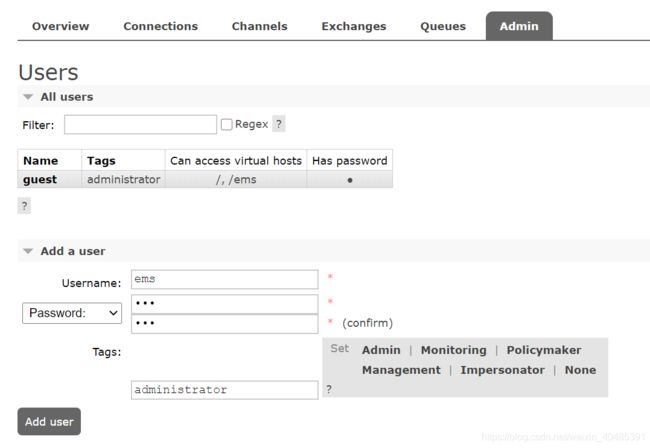
4.点击user目录下的name(我们设置的为ems),去配置它的虚拟主机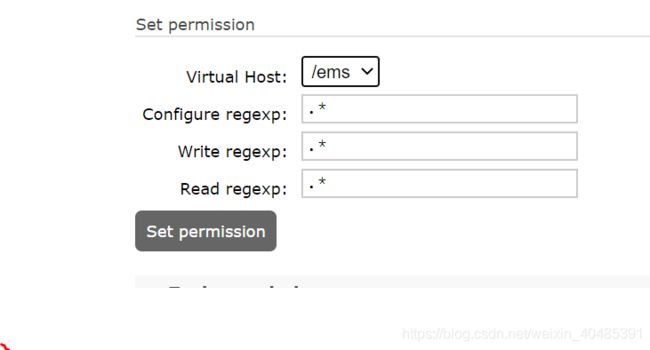
此时ems已经绑定/ems虚拟主机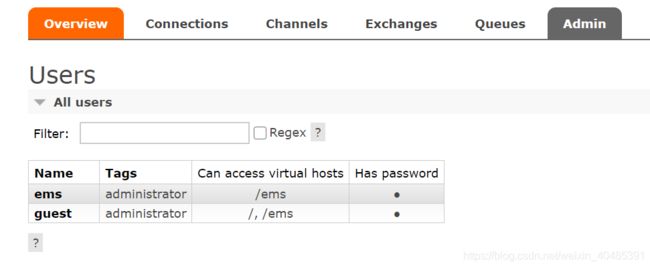
5.接着我们构建项目代码
public void sendMessage() throws IOException, TimeoutException {
//创建连接mq的工厂对象
ConnectionFactory connectionFactory=new ConnectionFactory();
//设置连接rabbitmq主机,端口号,虚拟主机,用户名,密码
connectionFactory.setHost("localhost");
connectionFactory.setPort(5672);
connectionFactory.setVirtualHost("/ems");
connectionFactory.setUsername("ems");
connectionFactory.setPassword("123");
//获取连接对象
Connection connection = connectionFactory.newConnection();
//获取连接中通道
Channel channel = connection.createChannel();
//通道绑定对应消息队列
//参数1:队列名称,不存在就自动创建
//参数2:是否需要持久化 true需要
//参数3:是否独占队列(只能一个通道用它) true独占
//参数4:是否完成队列后自动删除队列 true是
//参数5:额外附加参数
channel.queueDeclare("hello",false,false,false,null);
//发布消息
//参数1:交换机名称 参数2:队列名称 参数3:传递消息额外设置 参数4:消息具体内容
channel.basicPublish("","hello",null,"hello word mq".getBytes());
channel.close();
connection.close();
}
运行后,在 http://localhost:15672/#/queues会发现新建了一个hello队列并且放入了一条消息。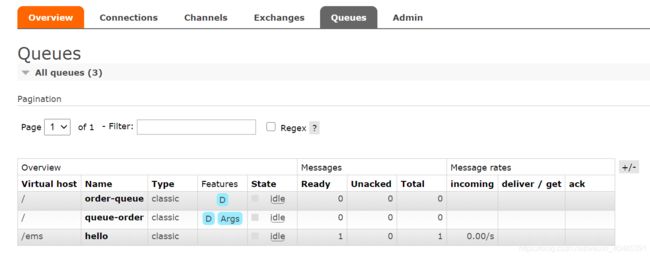
1.2.消费者
class Consumer {
public static void main(String[] args) throws IOException, TimeoutException {
ConnectionFactory connectionFactory = new ConnectionFactory();
//设置连接rabbitmq主机,端口号,虚拟主机,用户名,密码
connectionFactory.setHost("localhost");
connectionFactory.setPort(5672);
connectionFactory.setVirtualHost("/ems");
connectionFactory.setUsername("ems");
connectionFactory.setPassword("123");
//获取连接对象
Connection connection = connectionFactory.newConnection();
//获取连接中通道
Channel channel = connection.createChannel();
channel.queueDeclare("hello", false, false, false, null);
//消费消息
//参数1:被消费的队列名称
//参数2:自动确认机制
//参数3:消费时的回调接口
channel.basicConsume("hello", true, new DefaultConsumer(channel) {
@Override
//body中存放的消息
public void handleDelivery(String consumerTag, Envelope envelope, AMQP.BasicProperties properties, byte[] body) throws IOException {
System.out.println(new String(body));
}
});
}
}
运行后,如果不中断此线程,会持续接受队列中的信息。
注:很明显,我们的代码冗余度是非常大的,下面我们来简化。
使用如下applicat.yml中进行的应用配置
spring:
rabbitmq:
host: localhost
port: 5672
username: guest
password: guest
virtual-host: /
connection-timeout: 2000ms
template:
mandatory: true
listener:
simple:
prefetch: 2000
acknowledge-mode: manual
concurrency: 5
max-concurrency: 10
可节约掉如下代码
connectionFactory.setHost("localhost");
connectionFactory.setPort(5672);
connectionFactory.setVirtualHost("/ems");
connectionFactory.setUsername("ems");
connectionFactory.setPassword("123");
这个模型的缺点是可能造成消息在队列中堆积,从而造成不可预计的麻烦。
2.RabbitMq基本消息模型----work queue
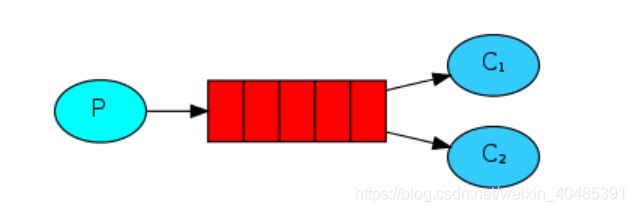
工作队列:(又名:任务队列)的主要思想是避免立即执行资源密集型任务,而不得不等待它完成。相反,我们安排任务在以后完成。我们将任务封装 为消息并将其发送到队列。在后台运行的工作进程将弹出任务并最终执行作业。当您运行许多工作人员时,任务将在他们之间共享(平均分配)。
与第一种模式的区别为:第一种只有一个消费者,而work queue允许多个消费者平均消息,以加快消费速度。
代码实现为在第一种直连模式的基础上,复制多份消费者并启动,在此不做演示
3.消息确认机制
简单说,在消费信息时,我们会设置是否自动确认接收到消息,在上面的例子中,两个消费者平均分配消息,从队列中取走信息会进行自动确认消息,队列就会删除此消息的信息。但这样的危害是,如果消费者拿到了消息,此时因为意外情况消费者挂掉了,那么没有执行业务逻辑的消息会全部丢失,这会给系统带来不小的风险。
解决方法:关闭自动消息确认,改为手动确认,在我们业务逻辑执行完之后,进行手动确认,这样就算消费者挂掉了,消息也还在队列中没有被删除,保证了系统的安全。
实现方法:把消费者改成如下,加注释的为新添代码。
class Consumer {
public static void main(String[] args) throws IOException, TimeoutException {
ConnectionFactory connectionFactory = new ConnectionFactory();
Connection connection = connectionFactory.newConnection();
Channel channel = connection.createChannel();
//设置每次只取一条消息
channel.basicQos(1);
channel.queueDeclare("work", true, false, false, null);
//参数2:自动确认机制(设置为不开启)
channel.basicConsume("work", false, new DefaultConsumer(channel) {
@Override
//body中存放的消息
public void handleDelivery(String consumerTag, Envelope envelope, AMQP.BasicProperties properties, byte[] body) throws IOException {
System.out.println("消费者2"+new String(body));
//手动确认机制
//参数1:需要确认的是哪个消息 (通过envelope的方法可得到消息的标签)
// 参数2:是否一次确认多个消息
channel.basicAck(envelope.getDeliveryTag(),false);
}
});
}
}
4.RabbitMq基本消息模型----fanout
又名扇出,广播模式。
消息发送流程如下:
- 可以有多个消费者
- 每个消费者有自己的queue
- 每个队列绑定到自己的Exchange(交换机)
- 生产者生产的消息只能发送到交换机,由交换机决定发给哪个队列。生产者无法决定。
- 交换机将消息发送给所有绑定过的队列
- 队列的消费者都可以拿到消息,实现一个队列有多个消费者。
5.RabbitMq基本消息模型----Routing之订阅模型Direct(直连)
在fanout中,一条消息,会被所有订阅的队列消费。但是,在某种场景下,我们希望不同的消息被不同的队列消费,这时就要用到Direct的Exchange。
在Direct模型下:
- 队列与交换机的绑定,不能是任意绑定了,而是要指定一个RoutingKey(路由key)
- 消息的发送方在向Exchange发送消息时,也必须指定消息的RoutingKey
- Exchange不再把消息交给某一个绑定的队列,而是根据RoutingKey判断,只有队列的RoutingKey与消息的RoutingKey相匹配,才会接收到消息。
package com.rabbitmq.routing;
import com.rabbitmq.client.*;
import com.rabbitmq.utils.Utils;
import java.io.IOException;
import java.util.concurrent.TimeoutException;
public class RoutingDirect {
public static void main(String[] args) throws IOException, TimeoutException {
Producter producter = new Producter();
producter.sendMessage();
}
}
class Producter {
public void sendMessage() throws IOException, TimeoutException {
Connection connection = Utils.getConnection();
Channel channel = connection.createChannel();
//创建交换机
//参数1:交换机名称
//参数2:direct 路由模式
channel.exchangeDeclare("logs_direct", "direct");
//设置routingkey
String routingkey = "info";
//发布消息
channel.basicPublish("logs_direct", routingkey, null, "这是routingkey发布的消息".getBytes());
channel.close();
connection.close();
}
}
class Consumer {
public static void main(String[] args) throws IOException, TimeoutException {
Connection connection = Utils.getConnection();
//获取连接中通道
Channel channel = connection.createChannel();
//通道绑定交换机
channel.exchangeDeclare("logs_direct", "direct");
//临时队列,没必要持久化,加大压力
String queue = channel.queueDeclare().getQueue();
//绑定交换机和队列
channel.queueBind(queue, "logs_direct", "error");
channel.basicConsume(queue, true, new DefaultConsumer(channel) {
@Override
//body中存放的消息
public void handleDelivery(String consumerTag, Envelope envelope, AMQP.BasicProperties properties, byte[] body) throws IOException {
System.out.println("消费者1" + new String(body));
//手动确认机制
//参数1:需要确认的是哪个消息 (通过envelope的方法可得到消息的标签)
// 参数2:是否一次确认多个消息
}
});
}
}
class Consumer2 {
public static void main(String[] args) throws IOException, TimeoutException {
Connection connection = Utils.getConnection();
//获取连接中通道
Channel channel = connection.createChannel();
//通道绑定交换机
channel.exchangeDeclare("logs_direct", "direct");
//临时队列,没必要持久化,加大压力
String queue = channel.queueDeclare().getQueue();
//绑定交换机和队列
channel.queueBind(queue, "logs_direct", "error");
channel.queueBind(queue, "logs_direct", "info");
channel.queueBind(queue, "logs_direct", "warning");
channel.basicConsume(queue, true, new DefaultConsumer(channel) {
@Override
//body中存放的消息
public void handleDelivery(String consumerTag, Envelope envelope, AMQP.BasicProperties properties, byte[] body) throws IOException {
System.out.println("消费者1" + new String(body));
}
});
}
}
注:就算只发布了一条消息,如果是相匹配的routingkey,则每个消费者都可以收到,类似微信公众号。(前面的都是一个消息只被消费一次)
6.RabbitMq基本消息模型----Topic
发送到主题交换机的消息不能具有任意的 routing_key-它必须是单词列表,以点分隔。这些词可以是任何东西,但通常它们指定与消息相关的某些功能。一些有效的路由关键示例:“ stock.usd.nyse ”,“ nyse.vmw ”,“ quick.orange.rabbit ”。路由关键字中可以包含任意多个单词,最多255个字节。
绑定密钥也必须采用相同的形式。主题交换背后的逻辑 类似于直接交换-用特定路由键发送的消息将传递到所有用匹配绑定键绑定的队列。但是,绑定键有两个重要的特殊情况:
- *(星号)可以代替一个单词。
- #(哈希)可以替代零个或多个单词。
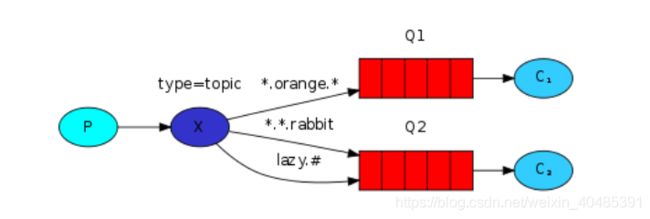
如下代码中消费者队列的routingkey一个为user.#,一个为user.*。- 消息的routingkey为
X.X,则两个都能消费到信息。 - 消息的routingkey为
X.X.X,则只有第一个可以消费到信息。
- 消息的routingkey为
package com.rabbitmq.topic;
import com.rabbitmq.client.*;
import com.rabbitmq.utils.Utils;
import java.io.IOException;
import java.util.concurrent.TimeoutException;
public class Topic {
public static void main(String[] args) throws IOException, TimeoutException {
Producter producter = new Producter();
producter.sendMessage();
}
}
class Producter {
public void sendMessage() throws IOException, TimeoutException {
Connection connection = Utils.getConnection();
Channel channel = connection.createChannel();
//创建交换机
//参数1:交换机名称
//参数2:direct 路由模式
channel.exchangeDeclare("topic", "topic");
//设置routingkey
String routingkey = "user.save.save";
//发布消息
channel.basicPublish("topic", routingkey, null, "这是topic发布的消息".getBytes());
channel.close();
connection.close();
}
}
class Consumer {
public static void main(String[] args) throws IOException, TimeoutException {
Connection connection = Utils.getConnection();
//获取连接中通道
Channel channel = connection.createChannel();
//通道绑定交换机
channel.exchangeDeclare("topic", "topic");
//临时队列,没必要持久化,加大压力
String queue = channel.queueDeclare().getQueue();
//绑定交换机和队列
channel.queueBind(queue, "topic", "user.#");
channel.basicConsume(queue, true, new DefaultConsumer(channel) {
@Override
//body中存放的消息
public void handleDelivery(String consumerTag, Envelope envelope, AMQP.BasicProperties properties, byte[] body) throws IOException {
System.out.println("消费者1" + new String(body));
//手动确认机制
//参数1:需要确认的是哪个消息 (通过envelope的方法可得到消息的标签)
// 参数2:是否一次确认多个消息
}
});
}
}
class Consumer2 {
public static void main(String[] args) throws IOException, TimeoutException {
Connection connection = Utils.getConnection();
//获取连接中通道
Channel channel = connection.createChannel();
//通道绑定交换机
channel.exchangeDeclare("topic", "topic");
//临时队列,没必要持久化,加大压力
String queue = channel.queueDeclare().getQueue();
//绑定交换机和队列
channel.queueBind(queue, "topic", "user.*");
channel.queueBind(queue, "topic", "info");
channel.queueBind(queue, "topic", "warning");
channel.basicConsume(queue, true, new DefaultConsumer(channel) {
@Override
//body中存放的消息
public void handleDelivery(String consumerTag, Envelope envelope, AMQP.BasicProperties properties, byte[] body) throws IOException {
System.out.println("消费者2" + new String(body))
}
});
}
}
3.Rabbitmq与Spring Boot集成
3.1 第一种hello world模型使用(一对一发布接受消息)
导入依赖,填写配置信息后,使用RabbitTemplate来简化操作,使用时直接在项目中注入即可。
-
开发生产者
//注入rabbitTemplate @Autowired private RabbitTemplate rabbitTemplate; @Test //参数1:routingkey 参数2:消息体 public void testHello(){ rabbitTemplate.convertAndSend("hello","hello world"); } -
开发消费者
//@RabbitListener接听指定队列,并传给@RabbitHandler去处理 @Component @RabbitListener(queuesToDeclare = @Queue("hello")) public class HelloCustomer { @RabbitHandler public void receive1(String message){ System.out.println("message = " + message); } }
3.2 第二种work模型使用(平均分配消息)
-
开发生产者
@Autowired private RabbitTemplate rabbitTemplate; @Test public void testWork(){ for (int i = 0; i < 10; i++) { rabbitTemplate.convertAndSend("work","hello work!"); } } -
开发消费者
@Component public class WorkCustomer { @RabbitListener(queuesToDeclare = @Queue("work")) public void receive1(String message){ System.out.println("work message1 = " + message); } @RabbitListener(queuesToDeclare = @Queue("work")) public void receive2(String message){ System.out.println("work message2 = " + message); } }说明:默认在Spring AMQP实现中Work这种方式就是公平调度,如果需要实现能者多劳需要额外配置
3.3 Fanout 广播模型(发布/订阅模式,无routingkey)
-
开发生产者
@Autowired private RabbitTemplate rabbitTemplate; @Test public void testFanout() throws InterruptedException { rabbitTemplate.convertAndSend("logs","","这是日志广播"); } -
开发消费者
@Component public class FanoutCustomer { @RabbitListener(bindings = @QueueBinding( value = @Queue, exchange = @Exchange(name="logs",type = "fanout") )) public void receive1(String message){ System.out.println("message1 = " + message); } @RabbitListener(bindings = @QueueBinding( value = @Queue, //创建临时队列 exchange = @Exchange(name="logs",type = "fanout") //绑定交换机类型 )) public void receive2(String message){ System.out.println("message2 = " + message); } }
3.4 Route 路由模型(发布/订阅模式,有routingkey)
-
开发生产者
@Autowired private RabbitTemplate rabbitTemplate; @Test public void testDirect(){ rabbitTemplate.convertAndSend("directs","error","error 的日志信息"); } -
开发消费者
@Component public class DirectCustomer { @RabbitListener(bindings ={ @QueueBinding( value = @Queue(), key={ "info","error"}, exchange = @Exchange(type = "direct",name="directs") )}) public void receive1(String message){ System.out.println("message1 = " + message); } @RabbitListener(bindings ={ @QueueBinding( value = @Queue(), key={ "error"}, exchange = @Exchange(type = "direct",name="directs") )}) public void receive2(String message){ System.out.println("message2 = " + message); } }
3.5 Topic 订阅模型(发布/订阅模型,动态路由模型,可指定routingkey的模型范围)
-
开发生产者
@Autowired private RabbitTemplate rabbitTemplate; //topic @Test public void testTopic(){ rabbitTemplate.convertAndSend("topics","user.save.findAll","user.save.findAll 的消息"); } -
开发消费者
@Component public class TopCustomer { @RabbitListener(bindings = { @QueueBinding( value = @Queue, key = { "user.*"}, exchange = @Exchange(type = "topic",name = "topics") ) }) public void receive1(String message){ System.out.println("message1 = " + message); } @RabbitListener(bindings = { @QueueBinding( value = @Queue, key = { "user.#"}, exchange = @Exchange(type = "topic",name = "topics") ) }) public void receive2(String message){ System.out.println("message2 = " + message); } }
4. MQ的应用场景
1.异步处理(发布/订阅模型)
场景说明:用户注册后,需要发注册邮件和注册短信,传统的做法有两种 1.串行的方式 2.并行的方式
串行方式:将注册信息写入数据库后,发送注册邮件,再发送注册短信,以上三个任务全部完成后才返回给客户端。 这有一个问题是,邮件,短信并不是必须的,它只是一个通知,而这种做法让客户端等待没有必要等待的东西.
并行方式:将注册信息写入数据库后,发送邮件的同时,发送短信,以上三个任务完成后,返回给客户端,并行的方式能提高处理的时间。
消息队列:假设三个业务节点分别使用50ms,串行方式使用时间150ms,并行使用时间100ms。虽然并行已经提高的处理时间,但是,前面说过,邮件和短信对我正常的使用网站没有任何影响,客户端没有必要等着其发送完成才显示注册成功,应该是写入数据库后就返回.消息队列: 引入消息队列后,把发送邮件,短信不是必须的业务逻辑异步处理
由此可以看出,引入消息队列后,用户的响应时间就等于写入数据库的时间+写入消息队列的时间(可以忽略不计),引入消息队列后处理后,响应时间是串行的3倍,是并行的2倍。
4.2 应用解耦
场景:双11是购物狂节,用户下单后,订单系统需要通知库存系统,传统的做法就是订单系统调用库存系统的接口.
这种做法有一个缺点:
当库存系统出现故障时,订单就会失败。 订单系统和库存系统高耦合. 引入消息队列
-
订单系统:用户下单后,订单系统完成持久化处理,将消息写入消息队列,返回用户订单下单成功。 -
库存系统:订阅下单的消息,获取下单消息,进行库操作。 就算库存系统出现故障,消息队列也能保证消息的可靠投递,不会导致消息丢失.
4.3 流量削峰
场景: 秒杀活动,一般会因为流量过大,导致应用挂掉,为了解决这个问题,一般在应用前端加入消息队列。
作用:
1.可以控制活动人数,超过此一定阀值的订单直接丢弃(我为什么秒杀一次都没有成功过呢^^)
2.可以缓解短时间的高流量压垮应用(应用程序按自己的最大处理能力获取订单)
-
用户的请求,服务器收到之后,首先写入消息队列,加入消息队列长度超过最大值,则直接抛弃用户请求或跳转到错误页面.
-
秒杀业务根据消息队列中的请求信息,再做后续处理.
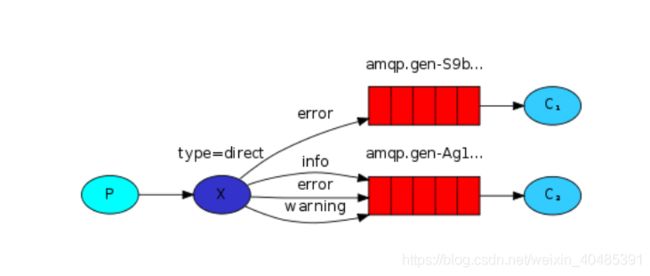



![[外链图片转存失败,源站可能有防盗链机制,建议将图片保存下来直接上传(img-6cvOkhmG-1598148693905)(RibbitMQ 实战教程.assets/SouthEast-20191127211247287.png)]](http://img.e-com-net.com/image/info8/9368ac5b28914d99a8a30c7746281892.jpg)
